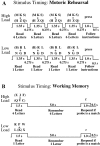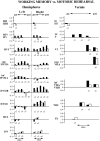Lobular patterns of cerebellar activation in verbal working-memory and finger-tapping tasks as revealed by functional MRI
- PMID: 9391022
- PMCID: PMC6573411
- DOI: 10.1523/JNEUROSCI.17-24-09675.1997
Lobular patterns of cerebellar activation in verbal working-memory and finger-tapping tasks as revealed by functional MRI
Abstract
The lobular distributions of functional activation of the cerebellum during verbal working-memory and finger movement tasks were investigated using functional magnetic resonance imaging (fMRI). Relative to a rest control, finger tapping of the right hand produced ipsilateral-increased activation in HIV/HV [Roman numeral designations based on Larsell's () nomenclature] and HVI and weaker activation in HVIII that was stronger on the ipsilateral side. For a working-memory task, subjects were asked to remember six (high load) or one (low load) visually presented letters across a brief delay. To assess the motoric aspects of rehearsal in the absence of working memory, we asked the subjects to repeatedly read subvocally six or one letters at a rate that approximated the internally generated rehearsal of working memory (motoric rehearsal task). For both tasks, bilateral regions of the superior cerebellar hemispheres (left superior HVIIA and right HVI) and portions of posterior vermis (VI and superior VIIA) exhibited increased activation during high relative to low load conditions. In contrast, the right inferior cerebellar hemisphere (HVIIB) exhibited this load effect only during the working-memory task. We hypothesize that HVI and superior HVIIA activation represents input from the articulatory control system of working memory from the frontal lobes and that HVIIB activation is derived from the phonological store in temporal and parietal regions. From these inputs, the cerebellum could compute the discrepancy between actual and intended phonological rehearsal and use this information to update a feedforward command to the frontal lobes, thereby facilitating the phonological loop.
Figures









References
-
- Adrian ED. Afferent areas in the cerebellum connected with the limbs. Brain. 1943;66:289–315.
-
- Allen G, Buxton RB, Wong EC, Courchesne E. Attention activation of the cerebellum independent of motor involvement. Science. 1997;275:1940–1943. - PubMed
-
- Awh E, Jonides J, Smith EE, Schumacher EH, Koeppe RA, Katz S. Dissociation of storage and rehearsal in verbal working memory: evidence from positron emission tomography. Psychol Sci. 1996;7:25–31.
-
- Baddeley A. Working memory. Science. 1992;255:556–559. - PubMed
-
- Brodal A. Neurological anatomy in relation to clinical medicine, Ed 3. Oxford UP; New York: 1981.
Publication types
MeSH terms
Grants and funding
LinkOut - more resources
Full Text Sources
Medical
